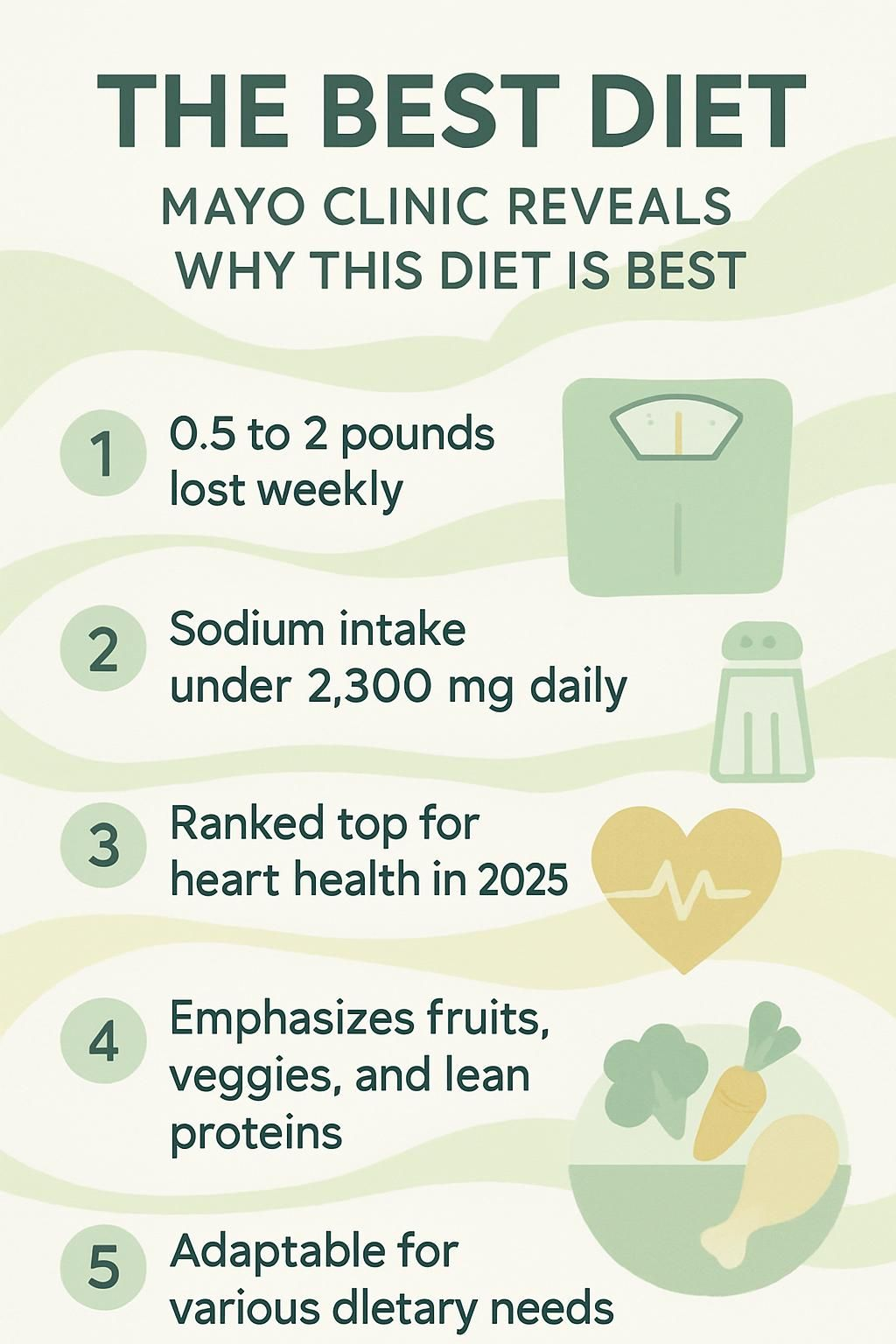The Best Diet: Mayo Clinic Reveals Why This Diet Is Best
Our Nutrition Assistant AI Suite will transform your body. You will lose fat, get toned, and build muscle. Gain confidence and optimal health.
Choosing the best diet can feel tricky. Many plans promise fast results, then fade. The Mayo Clinic Diet focuses on steady change and real food. It shares ideas with proven plans like the Mediterranean diet and the DASH diet.
This guide explains what makes an eating plan balanced, safe, and sustainable. You will see how the Mayo Clinic approach supports long-term weight loss, heart health, and daily energy. The goal is not strict rules. The goal is building habits that fit your life.
If you want a clear path forward, keep reading. You will learn what works, what to avoid, and how to start with confidence.
Key Takeaways
- The Mayo Clinic Diet targets gradual weight loss, about 0.5 to 2 pounds each week, using balanced meals and regular activity.
- Research reported in Nutrients (2022) links eating patterns rich in fruits, vegetables, whole grains, healthy fats, and lean protein with lower risks of heart disease and type 2 diabetes.
- U.S. News & World Report ranked the DASH diet first for heart health in 2025. The Mayo Clinic Diet uses similar principles while offering flexible, customizable menus.
- The plan trims saturated fat and added sugar, and suggests keeping sodium under 2,300 mg per day to support healthy cholesterol and blood pressure.
- Meal plans can fit vegetarian, gluten-free, and diabetes needs with guidance from healthcare professionals and Mayo Clinic resources reviewed in January 2023.

What makes a diet the best choice?

Many people look for a diet plan that helps with weight loss, energy, and disease prevention. The best choice improves your health and fits your routine. It should be flexible enough to use every day.
What is nutritional balance and why does it matter?
A balanced diet provides the nutrients your body needs to work well. That includes potassium, calcium, magnesium, fiber, and protein. It also keeps sodium, added sugar, and unhealthy fats lower.
The DASH diet and the Mediterranean diet both encourage whole grains, fruits and vegetables, beans, nuts and seeds, fish or poultry, and olive oil. They also limit highly processed foods.
Balanced eating supports long-term weight loss without supplements. In a 2022 Nutrients study, people who followed balanced patterns reduced their risk of cardiovascular disease and type 2 diabetes. Skipping whole food groups can cause vitamin and mineral gaps. Very low calorie plans may leave you tired and less focused.
Choosing unsaturated fats, such as olive oil and nuts, can lower total cholesterol and LDL cholesterol, which protects your heart. Unlike fad diets that cut entire food groups for quick loss, balanced plans help you build habits you can keep.
“Balanced eating is about variety. Aim for a colorful plate most days.”
How can a diet be sustainable long-term?
Sustainability starts with balance and foods you enjoy. Plans that leave you hungry or remove favorite foods often fail. Very low calorie programs or heavy reliance on meal replacements can also be costly.
The Mayo Clinic Diet stays flexible. You choose fruits and vegetables, lean proteins, whole grains, nuts, and healthy oils. You also eat enough fiber, which helps you feel full. Regular activity pairs with smart calorie control to support healthy blood pressure and weight over time.
Tracking progress, adjusting goals, and keeping meals realistic raise your chances of maintaining results. Small, steady steps work better than short bursts of strict rules.
What health benefits and disease prevention does a top diet offer?
Healthy patterns that center on plants, whole grains, olive oil, and lean protein have strong evidence behind them. The DASH and Mediterranean diets often lower blood pressure and LDL cholesterol within weeks. U.S. News & World Report lists DASH as the top plan for heart health in 2025.
Eating nutrient-dense foods can reduce risk factors for major chronic diseases. Omega-3 fats from fish may lower triglycerides and stroke risk. These patterns also help with weight control, type 2 diabetes management, and overall heart health. Many people report better mood and focus as their habits improve.
Choosing low-fat dairy instead of full-fat options supports bone health while limiting saturated fat and extra calories.
Overview of the Mayo Clinic Diet
The Mayo Clinic Diet is a healthy diet plan built around real food and practical routines. It helps you lose weight and keep it off by focusing on balanced plates and steady activity.
Foundation and core principles of the Mayo Clinic Diet
Mayo Clinic experts created the plan to support safe weight loss and long-term maintenance. You eat mostly fruits, vegetables, whole grains, lean proteins, nuts, and low-fat dairy. Foods high in saturated fat, such as fatty cuts of meat and snack foods, are limited. Occasional treats are allowed to prevent feelings of deprivation.
The expected loss is about 0.5 to 2 pounds per week. You build your meals from all major food groups rather than relying on pills or powders. The plan also encourages moving more and sitting less during the day.
Guidelines were reviewed in January 2023 to align with current research and best practices.
How lifestyle changes are incorporated
You create lasting habits around food, drink, and movement. A simple food journal helps you notice patterns and triggers, such as stress or ads that prompt cravings for sweets.
Set small goals, such as swapping white bread and pasta for whole grain versions, or choosing nuts instead of chips. Aim for at least 30 minutes of activity most days. Focusing on less saturated fat and more produce, whole grains, and lean proteins supports heart health while you lose weight.
Digital tools and guidance from registered dietitians can support your progress. After the early weight loss phase, keep a flexible meal plan that fits your schedule. Simple swaps, like skipping soda at lunch, add up over time.
How customizable meal plans work
Mayo Clinic meal plans are easy to adapt. You can match your cultural preferences or follow vegetarian or gluten-free needs. Ingredients come from regular grocery stores, so you can cook for the whole family without special products.
Clear serving sizes show how much to eat from each food group. Weekly planning supports your budget and routine. You can swap foods within groups, such as choosing oats instead of brown rice, or beans instead of poultry.
Mayo Clinic resources help you tailor your plan for diabetes or plant-forward eating. Each menu aims to balance carbohydrates and key nutrients like iron and zinc while limiting saturated fat and added sugar.
Key features of the Mayo Clinic Diet
The Mayo Clinic Diet prioritizes balance and flexibility, and it can reduce the risk of heart disease and some cancers, while supporting healthy weight.
Why focus on fruits, vegetables, and whole grains?
Fruits, vegetables, and whole grains supply fiber, vitamins, and minerals your body needs. DASH suggests several vegetable servings daily. Mediterranean-style eating also highlights two to three fruits and at least four vegetable servings each day.
Plant foods help lower blood pressure and LDL cholesterol. Whole grains support steady energy and digestive health. Large studies from the National Heart, Lung, and Blood Institute link fiber-rich diets with lower heart disease risk.
Mayo Clinic experts recommend making plants the base of your plate. For example, adding fruit to breakfast and vegetables to lunch often keeps you full longer than low-carb meals.
What role do healthy fats and lean proteins play?
Healthy fats and lean proteins help you feel satisfied and protect your heart. The plan favors unsaturated fats, such as olive oil, nuts, and seeds, instead of saturated or trans fat from processed foods.
Omega-3 fats from fish like salmon or sardines can reduce inflammation and support heart health. Lean proteins, including fish, poultry without skin, eggs, beans, and lentils, build and maintain muscle without extra saturated fat.
Eating seafood a few times each week and limiting red meat may lower triglycerides. These choices also fit well with Mediterranean and DASH patterns.
How does the diet reduce saturated fat and added sugars?
Limiting saturated fat and added sugar is central to weight control and heart health. The plan reduces red and processed meats and adds more plant foods like beans, vegetables, whole grains, nuts, and seeds.
Use olive or canola oil instead of butter. Keep desserts and sugary drinks for special moments. High added sugar can raise blood pressure over time. Low-fat dairy is included in moderation to reduce saturated fat.
Season foods with herbs, spices, citrus, and vinegar to cut back on salty sauces. Public health guidance suggests keeping sodium under 2,300 mg per day. That level supports healthy blood pressure as seen in DASH research.
Why is the Mayo Clinic Diet recommended?
Health professionals often recommend the plan because it is evidence-based and practical. It blends nutrition science with daily habits that you can maintain.
What weight loss results does it provide?
You can expect a loss of about 0.5 to 2 pounds per week. This pace aligns with safety guidance from U.S. health agencies. The focus is long-term success, not quick drops that are hard to keep.
Very restrictive plans, such as some keto or paleo versions, may bring fast loss early. Many people regain because the rules are hard to follow. The Mayo Clinic Diet builds steady habits using all food groups, which improves the odds of keeping the weight off.
People who keep up with balanced meals and activity often maintain better results. Tracking makes it easier to stay consistent.
How does it promote heart health and lower cholesterol?
Weight loss itself supports heart health, but food quality matters too. The plan encourages plenty of fruits, vegetables, and whole grains. Fiber in whole grains can bind cholesterol in the gut, so less enters the bloodstream.
Unsaturated fats from olive oil, nuts, seeds, and avocados replace saturated fat from butter and fatty meats. Swapping these fats often lowers LDL cholesterol and overall risk of heart disease. Keeping sodium below 2,300 mg per day can lower blood pressure, consistent with DASH and U.S. News & World Report findings.
These changes fit into daily life without strict rules. They also mirror principles of the Mediterranean diet, which includes omega-3 fish that protect the heart and brain.
How does it support long-term healthy habits?
The plan builds daily routines, such as keeping a food and activity log and setting clear, simple goals. You learn to spot triggers, like stress snacking, and plan responses that work for you.
Custom menus keep meals enjoyable. You focus on plants, lean protein, whole grains, and healthy fats, along with key minerals and vitamins. Online and in-person support can help you through tough weeks. Flexible tools let you adjust as life changes while staying on track.
How does the Mayo Clinic Diet compare to other top diets?
Comparing plans helps you choose the right fit. Look at how each one approaches food groups, flexibility, and long-term results.
How does it differ from the Mediterranean Diet?
The Mayo Clinic Diet focuses first on healthy weight loss. The Mediterranean diet centers on heart health and daily plant foods. Both include fruits, vegetables, whole grains, fish or poultry, and healthy oils.
Some Mediterranean plans allow moderate wine for adults who already drink, though research continues to show health risks with alcohol. Mediterranean meals often include seafood several times a week and limit red and processed meats. Many people find the Mayo Clinic menus easier to customize for their needs.
What are the differences with the DASH Diet?
DASH, or Dietary Approaches to Stop Hypertension, was developed with support from the National Heart, Lung, and Blood Institute. It puts a strong focus on lowering sodium. Typical guidance suggests cutting sodium to about 2,300 mg per day, with a lower target for greater blood pressure reduction.
DASH highlights whole grains, vegetables, fruits, fish, poultry, beans, and nuts. It keeps unhealthy fats and added sugars in check. Expert panels consistently rank DASH at the top for heart health and blood pressure control, including the 2025 U.S. News & World Report list.
DASH aims for gradual, realistic changes instead of strict rules. It also supports diabetes control and healthy cholesterol levels.
How does it compare to the Flexitarian Diet?
Both the Mayo Clinic Diet and the Flexitarian Diet are flexible and plant-forward. Neither requires giving up animal products completely. Both allow treats in moderation and encourage whole grains, fruits, and vegetables.
You can adapt either plan to personal or cultural needs. Each supports lasting habits for weight control and disease prevention.
Common questions about the Mayo Clinic Diet
Here are answers to common questions so you can decide if the plan fits your needs.
Can the Mayo Clinic Diet work for vegetarians?
Yes. The plan includes plant-based proteins like beans, lentils, nuts, and seeds. You can build menus that exclude animal products and still meet your protein needs.
The focus on produce and whole grains aligns well with vegetarian eating. Mayo Clinic dietitians provide guidance to keep your nutrient intake balanced, including iron, zinc, and vitamin B12 for those who avoid animal foods.
Is it appropriate for people with diabetes?
It can be. The plan emphasizes high-fiber foods, such as whole grains, fruits, vegetables, and lean proteins. It limits added sugars and refined carbs, which helps with blood sugar control.
DASH ranks very high for diabetes care in U.S. News & World Report 2025. The Mayo Clinic Diet can also work for diabetes when you track carbohydrates and portion sizes. Always talk with your healthcare professional before starting or changing an eating plan if you have diabetes or other medical conditions.
Can it be adapted for gluten-free diets?
Yes. You can choose naturally gluten-free grains like rice, quinoa, corn, and certified gluten-free oats. The plan does not require any single grain, so swaps are simple.
Fruits, vegetables, beans, and lean proteins are naturally gluten-free. Mayo Clinic resources offer tips for label reading, recipe swaps, and balanced gluten-free meal ideas.
How to get started on the Mayo Clinic Diet
Start with reliable information and build a simple plan. Use tools that make healthy choices easier day after day.
How do you set realistic goals?
Begin with your current habits and health needs. Create short-term and long-term goals. A safe target is 0.5 to 2 pounds per week, which matches Mayo Clinic guidance.
Track progress weekly using a notebook or app. Adjust goals as your health improves. Set targets that are challenging yet doable to maintain motivation.
How to identify your eating habits and triggers?
Keep a daily food and activity record. Note what you eat, when and where you eat, who you are with, and how you feel. Patterns often appear, such as late-night snacking or distracted eating in front of the TV.
Think about what worked or did not work in past efforts. Many people find that stress, boredom, or fatigue spark cravings. The Mayo Clinic program provides tools to track behavior and plan better responses.
How to create a personalized action plan?
After you find your patterns, build a plan that fits your life. Include food choices, activity goals, and special needs such as gluten-free or vegetarian meals.
- List healthy foods you enjoy and activities you are willing to do.
- Write clear goals for meals, snacks, shopping, and exercise in a journal or app.
- Use Mayo Clinic planning templates that respect cultural or religious food choices.
- Schedule weekly time for meal prep and grocery shopping to reduce last-minute choices.
- Ask a registered dietitian for support and adjustments as needed.
- Pick recipes that meet your health needs, such as lower sodium or higher fiber.
- Build flexibility into your week for social events and busy days.
- Spot likely obstacles early and list strategies, like batch cooking or freezer meals.
- Review progress weekly and tweak one small thing that is not working.
- Invite a friend or family member to join a walk or share healthy meals.
Breaking big goals into small steps makes change feel manageable, which helps you stick with it.
Tips for success on the Mayo Clinic Diet
Practical routines keep momentum strong. Use these ideas to make healthy choices your default.
How to incorporate regular physical activity?
Set a weekly target of at least 150 minutes of moderate activity, such as brisk walking or cycling. Spread it into 30-minute sessions on most days so it fits your schedule.
Try different options like swimming, dancing, or strength training until you find what you enjoy. Reduce sitting time by taking the stairs, standing during calls, or adding short walks after meals. Put workouts on your calendar and set reminders, which improves follow-through.
What is mindful eating and how to practice it?
Mindful eating means paying attention to what you eat and how full you feel. Slow down. Put away screens, chew well, and notice flavors and textures.
Check your hunger before the meal and stop when you feel satisfied, not stuffed. Many people find that mindful eating prevents overeating and reduces stress snacking. Simple habits like setting your fork down between bites or using smaller plates can help you notice portions.
How to stay motivated with small, achievable milestones?
Set daily or weekly mini goals, then track them. Celebrate each step, even the small ones. Visible progress builds confidence.
Use journals or apps for quick feedback. If you hit a rough patch, ask for support from peers, a coach, or a healthcare professional. Adjust goals as needed so they stay realistic and motivating.
Expert opinions on the Mayo Clinic Diet
Many clinicians and researchers support the plan because it is grounded in evidence and practical behavior change.
What research and clinical studies support it?
Studies in Nutrients (2022) link Mediterranean-style eating, which shares features with the Mayo Clinic Diet, to better heart and diabetes outcomes. Research on DASH shows that lowering sodium to about 2,300 mg per day can reduce blood pressure within weeks.
Work supported by the National Heart, Lung, and Blood Institute shows DASH helps reduce high blood pressure and LDL cholesterol. Evidence also suggests shifting some daily carbohydrates to protein or unsaturated fats can support heart health. Patterns rich in fruits, whole grains, lean proteins, and healthy fats are associated with longer life and fewer chronic diseases.
Which registered dietitians endorse the diet?
Registered dietitians often recognize the Mayo Clinic Diet as balanced and practical. Expert panels featured in U.S. News & World Report include dietitians who review and rank plans each year.
Dietitians at Mayo Clinic, such as Katherine Zeratsky, R.D., L.D., highlight its focus on fruits, vegetables, whole grains, lean proteins, and healthy fats. They value the plan’s flexibility for different needs, including vegetarian or diabetes-friendly menus. Many clients report steady weight loss and better heart markers when they follow the guidelines.
What challenges might you face and how to overcome them?
Every change brings hurdles. A few simple tactics can help you stay consistent without feeling stuck.
How to adjust to new eating habits?
Start with a food diary and set daily goals. Aim for a slow, steady loss of 0.5 to 2 pounds per week. Build meals around fruits, vegetables, whole grains, lean proteins, and healthy fats.
Talk with your healthcare professional before making major changes, especially if you have medical conditions. Review what has worked for you in the past, then apply those lessons. Plans like DASH or Mediterranean offer strong long-term health benefits and can blend with the Mayo Clinic approach.
How to stay consistent during social events?
Eat a healthy snack before you go so you are not overly hungry. Focus on conversations, not the buffet. Set a limit for treats, such as one small dessert, and skip foods you do not truly want.
Tell the host your preferences if that feels comfortable. Choose water or unsweetened drinks to save calories. Mindful choices at gatherings help you stay on track without feeling left out.
What are the benefits beyond weight loss?
The Mayo Clinic Diet supports your whole health, not just the number on the scale.
How does it improve energy levels?
Balanced meals with fiber-rich foods help stabilize blood sugar and prevent energy crashes. Nutrients like potassium, calcium, magnesium, and protein support steady energy through the day.
Regular activity helps you sleep better and feel less tired. Many people notice fewer afternoon slumps when they shift to plant-forward meals and healthy fats.
How does it reduce chronic disease risks?
Eating more fruits, vegetables, and whole grains can lower blood pressure, LDL cholesterol, and the risk of type 2 diabetes. DASH has strong evidence for heart health improvements in both adults and teens.
Replacing saturated fat with olive oil or nuts reduces inflammation and supports cardiovascular health. Limiting red meat and added sugars also helps reduce cancer risk factors.
How does it enhance mental well-being?
Diet patterns that include whole grains, fruits, and vegetables are linked with better mood and cognition. The Mayo Clinic Diet uses the same building blocks found in DASH and Mediterranean eating.
Regular physical activity helps ease anxiety and supports a positive outlook. Structured plans and social support can raise confidence as your habits improve.
Conclusion
The Mayo Clinic Diet offers a clear, sustainable path to better health. It supports safe weight loss, heart health, and daily energy with flexible meals you can enjoy. If you want the best diet for long-term results, this plan blends science, balance, and real-life habits.
Talk with your healthcare professional before starting any new eating plan, especially if you have a medical condition. Then begin with small steps. Over time, those steps add up to lasting change you can feel every day.
FAQs
1. What diet does the Mayo Clinic recommend as the best, and why?
The Mayo Clinic recommends a plant-focused eating plan rich in vegetables, fruits, whole grains, and lean proteins. Research shows this approach supports heart health, weight control, and lower risk of chronic diseases such as diabetes.
2. How effective is this diet for weight loss according to data?
Clinical studies show that people following a plant-based diet lose an average of 5 to 10 percent of their body weight over six months. This result comes from reduced calorie intake and increased fiber consumption.
3. Are there any risks or side effects linked with this recommended diet?
Most people tolerate a plant-rich eating pattern well; however, some may need to monitor vitamin B12 or iron levels if they eat little animal protein. Regular checkups can help address these needs.
4. Can you share a real-life example of someone using this diet successfully?
A patient at our clinic switched to more vegetables and whole grains after her doctor’s advice. Over one year she lost twenty pounds; her cholesterol dropped by thirty points based on lab results reviewed during follow-up visits.
Summary: The Mayo Clinic’s top-rated dietary plan centers on plants with proven benefits for health and weight management supported by clinical evidence and personal success stories.







